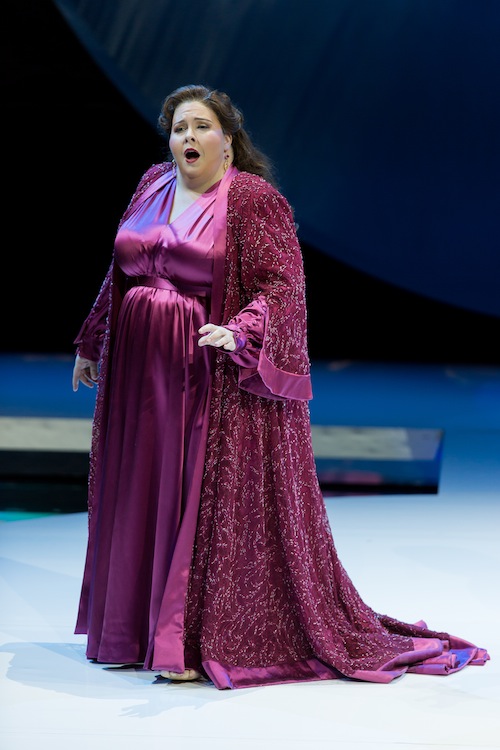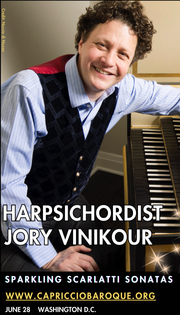Washington National Opera goes for Baroque with a radiant “Alcina”

Angela Meade stars in the title role of Handel’s “Alcina” at Washington National Opera. Photo: Scott Suchman
As with most large opera companies, music before Mozart has never been a high priority at Washington National Opera. The last Handel opera mounted by the company was Tamerlano in 2008, with Plácido Domingo in a leading role.
In a season heavy on 19th-century Italian opera, WNO is staging its first-ever production of Handel’s Alcina, heard at opening night on Saturday. The performance took place in the smaller Eisenhower Theater, thought more intimate for the limited instrumental and vocal forces of Baroque opera.
Angela Meade chose Washington to make her debut in this opera’s title role. The celebrated American soprano, who triumphed here in her first Norma in 2013, has a voice that is anything but limited in scope. Meade’s huge instrument is not a natural fit for early music, and the results felt a bit like using a machete to do a microsurgery. In many of her arias a compression of sound was evident, a sense of constraint undermining the role’s dramatic possibilities. As soon as the melodic or dynamic compass opened up a bit, Meade could relax and let the sound flow, making for some thrilling moments.
The soprano hit her stride in “Ah! Mio cor!” from Act II, which served here as the conclusion to the first part of the performance. As the role became more emotionally expansive–especially in the scena ending with “Ombre pallide”– Meade’s power, at both ends made the wronged Alcina into a terrifying figure. The arias in Act III only got better from there. Although some more dazzling cadenzas and high-flying ornamentation on the da capo repeats would have gone a long way towards the feeling of a big voce being held firmly in reserve.
Ying Fang had a stellar company debut as Morgana, Alcina’s sister. The Chinese soprano’s light and airy voice soared in her cadenza and embellished da capo in “O s’apre al riso.” The top notes could sometimes turn shrill, but not in her show-stopping rendition of the brilliant showpiece “Tornami a vagheggiar” or the melancholy “Credete al mio dolore,” complete with a poignant cello solo with its own cadenza.
Mezzo-soprano Elizabeth DeShong was effective in the castrato role of Ruggiero, which she sang almost a decade ago at Wolf Trap Opera. Her runs were exceptionally clean, and she deployed her petite and concentrated voice to maximum effect in this role’s gorgeous arias.
Daniela Mack made a stronger impression as Bradamante than she had in Santa Fe Opera’s production this summer. The fluttery vibrato seemed less pronounced, making her slow arias more mellifluous, and the ornaments on the da capo repeats, including some interpolated high notes, were the most thrilling of the evening.
Tenor Rexford Tester, recently of the Domingo-Cafritz Young Artist Program, was a solid Oronte, the general in love with Morgana, with lyrical smoothness in the melismas. The young baritone Michael Adams, a current young artist who was a standout in last season’s Madama Butterfly, had a pleasing sound as Melisso, Bradamante’s tutor. A small chorus of about twenty singers, carefully prepared by Steven Gathman, were balanced and precise in the opening and closing numbers but spent far too much time milling around the edges of scenes.
Most companies experienced in mounting Baroque operas collaborate with a historically informed performance ensemble. WNO has at least engaged a specialist conductor this time around, the capable veteran Jane Glover, director of Chicago’s Music of the Baroque. Leading from one of two harpsichords, where she accompanied most of the recitatives, Glover presided over a disciplined, often radiant performance by the Kennedy Center Opera House Orchestra.
The violin sound, so predominant in Handel, was ultra-refined and unified, and the addition of a theorbo player, Richard Stone, provided timbral variety in the continuo. Violinist Michelle Kim had a gorgeous solo in Morgana’s aria “Ama, sospira,” appearing at the edge of the stage.
Anne Bogart’s production is in the same vein as her Norma in 2013. A plain, abstracted set features an island-like platform, with a circle also cut out of a plain backdrop (sets by Neil Patel). The only visual variety comes in Christopher Akerlind’s lighting that shifts to various colors, echoed in the mostly plain-colored, modern-leaning costumes by James Schuette.
Four dancers choreographed pleasingly by Barney O’Hanlon enlivened the action. Unfortunately, most of Handel’s exquisite ballet music was cut, along with the role of the boy Oberto and about 30 minutes of music.
Between these dances and Jessica Lang’s mesmerizing choreography for Aida earlier this fall, it should be clear that opera and ballet belong together. Washington National Opera should try to collaborate regularly with Washington Ballet or another company in the coming years, to join its audiences together.
Alcina runs through November 19 with the same cast, except for a single performance by Domingo-Cafritz Young Artists on November 18. kennedy-center.org; 202-467-4600.

